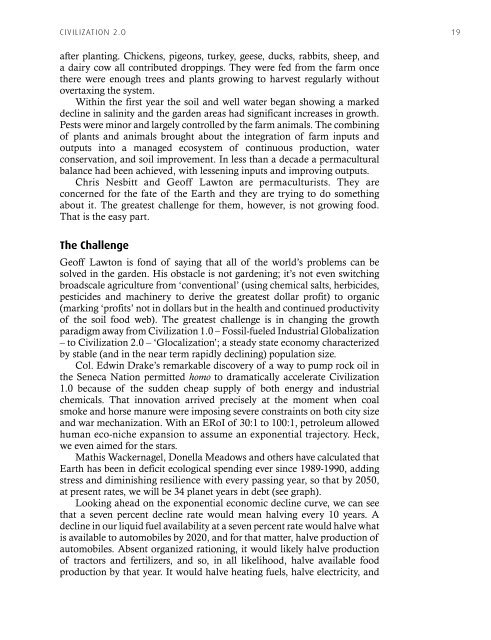Designing Ecological Habitats - Gaia Education
Designing Ecological Habitats - Gaia Education
Designing Ecological Habitats - Gaia Education
You also want an ePaper? Increase the reach of your titles
YUMPU automatically turns print PDFs into web optimized ePapers that Google loves.
civilization 2.o 19<br />
after planting. Chickens, pigeons, turkey, geese, ducks, rabbits, sheep, and<br />
a dairy cow all contributed droppings. They were fed from the farm once<br />
there were enough trees and plants growing to harvest regularly without<br />
overtaxing the system.<br />
Within the first year the soil and well water began showing a marked<br />
decline in salinity and the garden areas had significant increases in growth.<br />
Pests were minor and largely controlled by the farm animals. The combining<br />
of plants and animals brought about the integration of farm inputs and<br />
outputs into a managed ecosystem of continuous production, water<br />
conservation, and soil improvement. In less than a decade a permacultural<br />
balance had been achieved, with lessening inputs and improving outputs.<br />
Chris Nesbitt and Geoff Lawton are permaculturists. They are<br />
concerned for the fate of the Earth and they are trying to do something<br />
about it. The greatest challenge for them, however, is not growing food.<br />
That is the easy part.<br />
The Challenge<br />
Geoff Lawton is fond of saying that all of the world’s problems can be<br />
solved in the garden. His obstacle is not gardening; it’s not even switching<br />
broadscale agriculture from ‘conventional’ (using chemical salts, herbicides,<br />
pesticides and machinery to derive the greatest dollar profit) to organic<br />
(marking ‘profits’ not in dollars but in the health and continued productivity<br />
of the soil food web). The greatest challenge is in changing the growth<br />
paradigm away from Civilization 1.0 – Fossil-fueled Industrial Globalization<br />
– to Civilization 2.0 – ‘Glocalization’; a steady state economy characterized<br />
by stable (and in the near term rapidly declining) population size.<br />
Col. Edwin Drake’s remarkable discovery of a way to pump rock oil in<br />
the Seneca Nation permitted homo to dramatically accelerate Civilization<br />
1.0 because of the sudden cheap supply of both energy and industrial<br />
chemicals. That innovation arrived precisely at the moment when coal<br />
smoke and horse manure were imposing severe constraints on both city size<br />
and war mechanization. With an ERoI of 30:1 to 100:1, petroleum allowed<br />
human eco-niche expansion to assume an exponential trajectory. Heck,<br />
we even aimed for the stars.<br />
Mathis Wackernagel, Donella Meadows and others have calculated that<br />
Earth has been in deficit ecological spending ever since 1989-1990, adding<br />
stress and diminishing resilience with every passing year, so that by 2050,<br />
at present rates, we will be 34 planet years in debt (see graph).<br />
Looking ahead on the exponential economic decline curve, we can see<br />
that a seven percent decline rate would mean halving every 10 years. A<br />
decline in our liquid fuel availability at a seven percent rate would halve what<br />
is available to automobiles by 2020, and for that matter, halve production of<br />
automobiles. Absent organized rationing, it would likely halve production<br />
of tractors and fertilizers, and so, in all likelihood, halve available food<br />
production by that year. It would halve heating fuels, halve electricity, and







